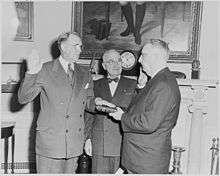Charles Edward Wilson (businessman)
Charles Edward Wilson (November 18, 1886 in New York City – January 3, 1972 in Bronxville, New York) was a CEO of General Electric.[1]
Charles Wilson | |
|---|---|
 Wilson (left) being sworn in | |
| Director of the Office of Defense Mobilization | |
| In office December 16, 1950 – March 31, 1952 | |
| President | Harry S. Truman |
| Preceded by | Position established |
| Succeeded by | John R. Steelman (Acting) |
| Chairman of the President's Committee on Civil Rights | |
| In office December 5 1946 – December 1947 | |
| President | Harry S. Truman |
| Preceded by | Committee established |
| Succeeded by | Committee disbanded |
| Personal details | |
| Born | Charles Edward Wilson November 18, 1886 New York City, New York, U.S |
| Died | January 3, 1972 (aged 85) Bronxville, New York, U.S. |
| Political party | Democratic |
Early life
Wilson left school at the age of 12 to work as a stock boy at the Sprague Electrical Works, which was acquired by the General Electric Company. He took night classes to graduate from high school, and he worked his way up to the position of president of the corporation in 1939.
Public Service
During World War II, Wilson served on the War Production Board as its executive vice-chairman in September 1942, supervising the huge American war production effort.[2] He resigned in August 1944 after a bitter dispute over jurisdiction with the Department of War and the Department of the Navy.
Wilson returned to General Electric in 1945 and began an anti-union campaign. He also served President Harry S. Truman as the chairman of the blue-ribbon President's Committee on Civil Rights in 1946 to 1947. The committee recommended new civil rights legislation to protect "all parts of our population."
General Electric career
After returning to General Electric, he left to become head of the new Office of Defense Mobilization in December 1950, which took control of the US economy, rationing raw materials to the civilian economy, a position so powerful that the press began calling him the "co-president." After being accused of backing big business, he resigned in March 1952 after a bitter dispute with his own Wage Stabilization Board, which had recommended wage increases for unionized steel workers without his knowledge. He intervened to back the steel companies' demand for price increases to offset them, only to see Truman back the board.
Later life
Wilson next returned to General Electric briefly, before becoming chairman of the board of W.R. Grace & Co. until his retirement in 1956, when he became the president of the People-to-People Foundation, a nonpartisan program promoting international friendship and understanding.
In 1944, after the end of the Second World War, Wilson stated that the US must keep her economy on a war footing to avoid another Great Depression.
John G. Forrest, wrote in The New York Times, "Charles Wilson is a big man by any standard, physical, moral, or mental."
Electric Charlie and his wife adopted their daughter, Margaret Wilson, from an orphanage when she was 18 years old. Margaret later married Hugh Pierce and they had one son, named for his grandfather and father: Charles Edward Wilson Pierce.
Charles Wilson died in Westchester County, New York, in 1972, and his remains are interred in a private mausoleum in the Kensico Cemetery.
Nickname
He was nicknamed "Electric Charlie" to avoid being confused with Charles Erwin Wilson, US Secretary of Defense under President Dwight Eisenhower and earlier the Chairman of the General Motors Corporation, who was nicknamed "Engine Charlie." (This nicknaming meme included at least one other contemporary American industrialist, Charles E. Sorensen, who was "Cast-Iron Charlie.")
References
- "GE History - Past Leaders". www.ge.com. December 7, 2012.
- Herman, Arthur. Freedom's Forge: How American Business Produced Victory in World War II, pp. 194, 199, 241, Random House, New York, NY, 2012. ISBN 978-1-4000-6964-4.
- Pierpaoli, Paul G., Jr. Truman and Korea: The Political Culture of the Early Cold War. Columbia: University of Missouri Press, 1999.
- Sandler, Stanley (editor), "The Korean War: An Encyclopedia", Garland, 1995, pages 357 - 58.
External links
| Business positions | ||
|---|---|---|
| Preceded by Gerard Swope |
President of the General Electric Company 1940–1942 |
Succeeded by Gerard Swope |
| President of the General Electric Company 1945–1950 |
Succeeded by Ralph J. Cordiner | |
| Awards and achievements | ||
| Preceded by Claire Lee Chennault |
Cover of Time 13 December 1943 |
Succeeded by Greer Garson |
| Political offices | ||
| New office | Director of the Office of Defense Mobilization 1950–1952 |
Succeeded by John R. Steelman Acting |